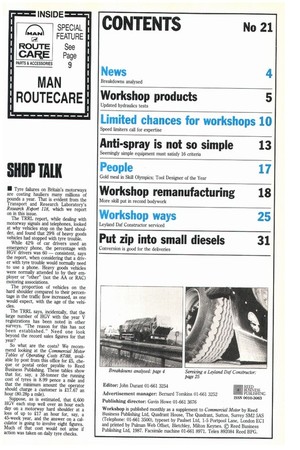SHOP TALK
Page 111

If you've noticed an error in this article please click here to report it so we can fix it.
in Tyre failures on Britain's motorways are costing hauliers many millions of pounds a year. That is evident from the Transport and Research Laboratory's Research Report 118, which we report on in this issue.
The TRRL report, while dealing with motorway signals and telephones, looked at why vehicles stop on the hard shoulder, and found that 29% of heavy goods vehicles had stopped with tyre trouble.
While 42% of car drivers used an emergency phone, the percentage with HGV drivers was 60 — consistent, says the report, when considering that a driver with tyre trouble would normally need to use a phone. Heavy goods vehicles were normally attended to by their employer or "other" (not the AA or RAC) motoring associations.
The proportion of vehicles on the hard shoulder compared to their percentage in the traffic flow increased, as one would expect, with the age of the vehicles.
The TRRL says, incidentally, that the large number of HGV with the year V registrations has been noted in other surveys. "The reason for this has not been established." Need one look beyond the record sales figures for that year?
So what are the costs? We recommend looking at the Commercial Motor Tables of Operating Costs 87188, available by post from this office for 25, cheque or postal order payable to Reed Business Publishing. These tables show that for, say, a 38-tonner the running cost of tyres is 8.99 pence a mile and that the minimum amount the operator should charge a customer is £17.67 an hour (80.28p a mile).
Suppose, as is estimated, that 6,600 HGV each stop well over an hour each day on a motorway hard shoulder at a loss of up to £17 an hour for, say, a 45-week year, and the answer on a calculator is going to involve eight figures. Much of that cost would not arise if action was taken on daily tyre checks.
















































































































































